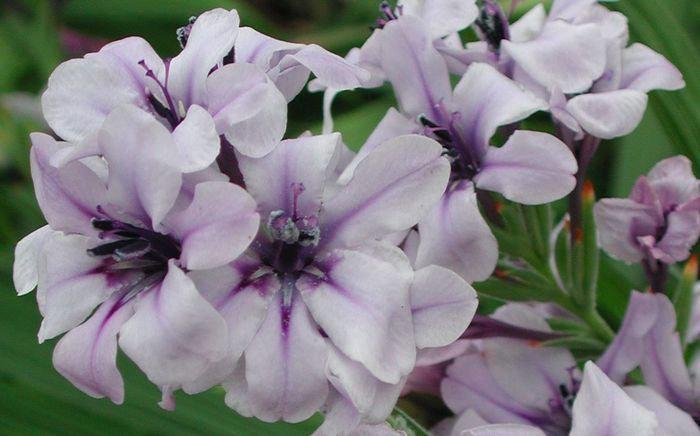Babiana fragrans

Description
Babiana fragrans is a deciduous, cormous geophyte, with an erect habit and branched stems, 70-200 mm tall. It has hairy, pleated, dagger-shaped leaves that sprout from the corm in mid to late winter. It has strongly sweet-scented, long-lasting, zygomorphic, violet to pale blue flowers, that occur on a branched inflorescence in winter to spring (July-September).Each flower has a 18-25 mm long tube that flares out to 6 lobes; the lower 3 lobes are smaller and paler than the upper 3 and often have yellow markings. Flowers are followed by small, rounded seed capsules; its seeds are easily dispersed around the parent plant, as they are shaken out of the capsules by wind, and the species can easily self-seed.
Propagation instructions - seeds
Seeds must be sown in autumn (March), planted in a sifted mixture of soil/sand and compost (50/50), and covered with soil that is equal in depth to the diameter of the seed. It must be planted in a deep seed tray because, as the seedling grows, it will pull itself down. To maximize percentage germination, the seeds can be leached, scarified or soaked. Soil must be kept moist until germination, which will take 6 weeks or longer. During germination, seeds must receive less light intensity, higher temperature and more moisture or relative humidity. Seedlings should not be allowed to dry out. Low concentrated liquid fertilizer can be used every 3 months.
In cold climates, propagation of seeds must be done in a cool greenhouse, because the young plants are susceptible to cold.
The plant thrives in a full sun position, and well-drained, acidic soil. It is not frost hardy. It needs water in autumn, winter and spring, and to be kept dry in summer. It is best suited to a sunny rockery in a winter-rainfall region. It is also suitable for containers.
Sources and references
Scientific name
Babiana fragrans
Common name(s)
fragrant blue babiana
Features
- Attracts butterflies
- Drought-resistant
- Edible
- Fragrant
- Good potplant
- Suitable for clay soil
- Suitable for sandy soil
- This will attract honey bees
